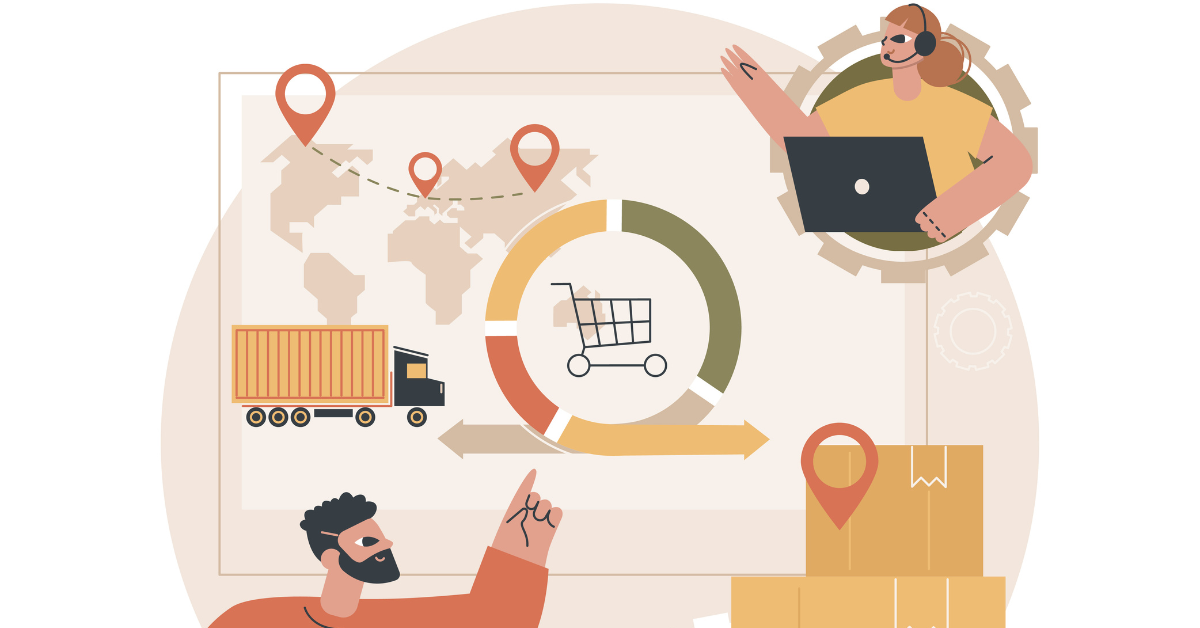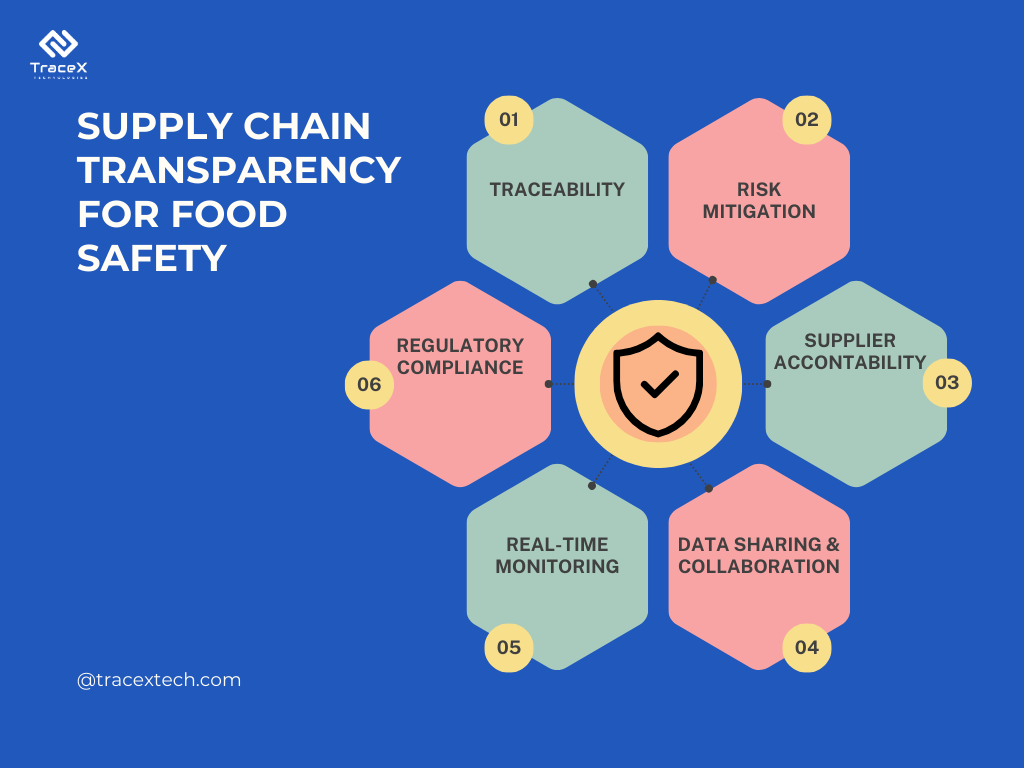Contact: +91 99725 24322 |
Menu
Menu
Quick summary: Discover how supply chain transparency enhances food safety by ensuring traceability, accountability, and consumer trust. Learn why it’s crucial for modern food systems and how businesses can implement transparent practices to protect public health.

Imagine walking into your favorite grocery store, confidently selecting fresh produce, only to find out later that it came from a farm with questionable safety practices. Scary, right? In today’s world, food safety is more crucial than ever, yet many consumers are left in the dark about where their food truly comes from. This lack of supply chain transparency can lead to serious health risks, making it vital for businesses to embrace openness and traceability.
According to Label Insight, 70% of consumers are willing to pay a premium for products from companies that are transparent about their supply chains and sourcing practices.
Recent headlines about food contamination highlight the importance of knowing exactly where our food comes from. Food safety is paramount, but how can you be sure the food you eat is truly what it claims to be? By ensuring that every step of the journey—from farm to table—is clear and accountable, we can protect consumers and build trust in the food they eat.
Key Takeaways
Food safety is an essential cornerstone of public health. Contaminated food can cause a wide range of illnesses, from mild discomfort to life-threatening conditions. These illnesses not only impact individual well-being but also place a significant burden on healthcare systems. Ensuring food safety throughout the supply chain, from farm to fork, is crucial to protect consumers and promote a healthy society. Food safety is not just a regulatory requirement; it’s a fundamental aspect of consumer trust and brand reputation. Incidents of contamination or adulteration can have devastating effects on public health and your business. Therefore, ensuring food safety across the supply chain is crucial.
The procurement of raw ingredients, production, processing, packaging, distribution, and retail are some of the major parts of the food supply chain. Various parties, including farmers, manufacturers, distributors, and merchants, are involved at each stage. It is essential to maintain transparency and safety throughout these stages in order to provide consumers with high-quality food products while reducing the likelihood of fraud or contamination.
Food safety difficulties in the supply chain include poor quality control, scant traceability, and intricate international distribution systems. Inconsistencies in safety precautions may result from regional differences in laws and norms. A prompt reaction to recalls or outbreaks can be hampered by poor communication amongst parties. Fraudulent actions can also undermine authenticity. To address these issues and ensure that customers are provided with safe and secure food, it is necessary to work collaboratively, use cutting-edge tracking technology, and harmonize international standards.
Incorporating supply chain transparency into food safety strategies is crucial for preventing incidents, safeguarding public health and fostering trust among consumers. It ensures that the journey of food products is well documented, monitored and optimized to meet the highest safety standards at every step.
In today’s interconnected global food supply chains, where products traverse numerous stages and locations, maintaining safety and quality is paramount.

Traceability entails keeping track of and documenting a product’s movement along the supply chain. Real-time data is provided through tracking technologies like RFID, barcodes, and blockchain, providing transparency, cutting down on fraud, and improving safety.
Barcodes are visual representations of data about products that may be scanned to retrieve information. Automatic identification and tracking are made possible by Radio Frequency Identification (RFID), which employs radio waves to send data between tags and readers. In order to improve product safety and consumer confidence across a variety of industries, including food, both technologies enable precise and effective product monitoring, inventory management, and quality control.
A decentralized digital ledger called blockchain securely logs and preserves transactions among a network of computers. Transparency, immutability, and traceability of data are all guaranteed. By providing an unchangeable record of the origin, handling, and distribution of products, blockchain technology can be utilized in the food business to trace and validate each step of the supply chain, boosting food safety and fostering consumer trust.
For a supply chain to run smoothly, data sharing and information flow must be effective. The timely and accurate transmission of data is ensured via clear communication between stakeholders, including suppliers, manufacturers, distributors, and retailers. This promotes real-time visibility over production, distribution, and inventory, enabling prompt responses to alterations or disruptions. Collaboration in information exchange also improves traceability, allowing for quicker recalls or corrective actions that ultimately ensure the quality and safety of the product.
A sustainable supply chain depends heavily on collaborative relationships with suppliers. An environment of cooperation is fostered by open communication, trust, and common goals. The likelihood of an overstock or a shortage is decreased by collaborative planning, production, and distribution, which guarantees that suppliers are responsive to changes in demand. Additionally, collaborative efforts in quality assurance, openness, and innovation result in safer products and effective operations. Maintaining these connections leads to a strong supply chain that can respond to difficulties and consistently provide value to both businesses and customers.
Utilizing technologies like GPS and IoT sensors to track products’ location, temperature, and condition along the supply chain constitutes real-time monitoring of food transportation. Because of the immediate data updates and alerts made possible by this, products are kept inside the predetermined parameters and timetables. Enhanced visibility, decreased spoilage, and the ability to take quick corrective action in the event of deviations are all benefits of real-time monitoring, which ultimately improves food safety, quality, and supply chain effectiveness.
In today’s complex and interconnected food supply chains, ensuring quality and safety are paramount. The ability to swiftly and effectively manage food recalls is critical to protecting consumers and maintaining brand reputation. This is where traceability solutions play a pivotal role. Farm to fork traceability empowers businesses to quickly and accurately identify affected batches and distribution channels, in the event of safety concerns or quality issues.
To guarantee that food is consumed safely, international and regional food safety regulations are established. While areas have their own regulatory agencies, such as the Food and Drug Administration (FDA) in the United States or the European Food Safety Authority (EFSA) in Europe, organizations like the World Health Organization (WHO) set global standards. By regulating topics including food processing, labelling, pollutants, additives, and more, these regulations harmonize procedures and protect the health of consumers.
Following established standards and practices is necessary for compliance with food safety legislation. This calls for keeping track of the sourcing, production, and distribution processes. Accurate and timely information must be sent to regulatory authorities as part of reporting responsibilities. These controls guarantee that goods adhere to safety requirements and can be identified in the event of problems. In addition to preserving consumer confidence, compliance and reporting show a commitment to moral standards and regulatory requirements, fostering a reliable food supply chain.
To ensure food safety and quality, third-party audits and certifications are crucial. Independent auditors provide an independent assessment of a company’s practices by determining if they are in accordance with industry norms and regulations. Obtaining certifications from organizations like HACCP, ISO, or GFSI shows a dedication to strict safety procedures. These validations increase consumer confidence, open up new markets, and boost internal operations, resulting in the ongoing development of the supply chain’s capacity to produce dependable and safe food goods.
The TraceX Food Traceability Platform is a cutting-edge solution designed to enhance transparency and safety throughout the food supply chain. Utilizing blockchain technology, the platform creates an immutable record of every transaction, enabling end-to-end traceability from farm to fork. It integrates with IoT devices to monitor environmental conditions during transportation and storage, ensuring food products are kept under optimal conditions. With a user-friendly dashboard, stakeholders can access real-time data, generate customizable reports, and maintain regulatory compliance with ease. Moreover, TraceX empowers consumers by providing them with access to information about the origins and safety of their food, fostering trust and confidence. Ultimately, the platform streamlines operations, mitigates risks, and supports a more accountable food system, making it essential for businesses in today’s food industry.
TraceX provided Svojas with a system for capturing data throughout the millet supply chain, from farm to fork. This data included details like farmer location, storage conditions, and processing steps.
Consumers can access this information through QR codes or dedicated platforms. This transparency allows consumers to see exactly where their food comes from and how it was handled, building trust in the safety and quality of Svojas’ millet products.
TraceX’s blockchain technology creates a tamper-proof record of all stages in the millet journey. This allows Svojas to identify the source of any potential contamination issues quickly and efficiently.
In the event of a recall, TraceX helps Svojas pinpoint specific batches and their distribution channels, minimizing the risk of consumers consuming unsafe products. This targeted approach reduces food waste and protects consumer health.
Real-time data from the TraceX platform allows Svojas to monitor storage conditions throughout the supply chain. This enables them to identify and address any potential issues, like improper temperature control, that could compromise food safety.
By analyzing data trends, Svojas can identify areas for improvement in their food safety protocols, further enhancing the overall safety of their millet products.
By providing consumers with detailed information about their products and demonstrating a commitment to traceability, Svojas builds consumer confidence in the safety and quality of their millets. This can be a significant competitive advantage in today’s market, where consumers increasingly prioritize transparency and ethical sourcing.
Overall, Svojas utilizes TraceX to create a transparent and traceable supply chain for their millet products. This empowers consumers to make informed choices and provides Svojas with valuable data for ensuring the highest food safety standards.
Supply chain transparency for food safety is a crucial component of contemporary business practices, to sum up. It includes utilizing real-time monitoring, blockchain, RFID, and other technology to guarantee the traceability, authenticity, and quality of food products. Transparency has many advantages, despite difficulties including data privacy, opposition to change, and compliance obligations. It increases consumer confidence, reduces risks, and encourages ethical behavior. Businesses may promote a food supply chain that is safer, more durable, and customer-focused by putting openness first.
Supply chain transparency refers to the clear visibility of the journey food products take from production to consumption. It involves documenting and sharing information about sourcing, processing, and distribution, ensuring that all stakeholders, including consumers, can trace the origins and safety practices of the food they purchase.
Supply chain transparency is vital for food safety as it allows for rapid identification and resolution of potential safety issues, such as contamination or spoilage. By having access to detailed information about food sources and handling practices, businesses can respond quickly to product recalls and enhance overall product safety, thereby protecting public health.
As conscious consumerism is in the rise, businesses can improve supply chain transparency by implementing technologies like blockchain for secure data sharing, utilizing IoT devices for real-time monitoring of food conditions, and establishing clear communication channels with all stakeholders. Additionally, providing consumers with easy access to traceability information, such as QR codes on packaging, can further enhance transparency and build trust.
